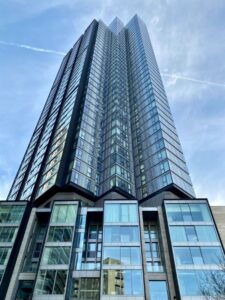building safety
The building safety occupation regime and the Golden Thread – filling in the details

In this article, Erin Broughton, Associate at Addleshaw Goddard, looks at the Safety Risk Regulations that came into force on 16 January, and provides further detail on how those responsible must manage safety risks at occupied higher-risk buildings.
New legislation enforcing parts of the Building Safety Act 2022 (“BSA”) is coming in thick and fast, and with minimal warning or fanfare.Accountable Persons (“AP”s) and Principle Accountable Persons (“PAP”s) of higher-risk buildings need to be aware of the Higher-Risk Buildings (Management of Safety Risks etc) (England) Regulations 2023 (the “Safety Risk Regulations”). For an overview of who is an AP and a PAP, please see our previous article here.Overview of new obligations

Credit: Unsplash/CrowN
The new obligations include, but are not limited to:
- A safety case report must be in place as soon as reasonably practicable after a building is occupied, or a person becomes a PAP for the building. It must also be provided to the Building Safety Regulator (“BSR”) who must be notified if a safety case report is revised.
- A PAP must have a mandatory occurrence reporting system in place and require APs to report certain safety occurrences via the system. One topical example includes RAAC issues, which will need to be reported as a mandatory occurrence. The reporting system must be accessible to all residents and other users of the building.
- The PAP must put in place a resident engagement strategy as soon as reasonably practicable, and must review the strategy at least every two years and after a mandatory occurrence report or significant material alterations to the building.
- The PAP must establish and operate a complaint system and publish a complaints policy. The Safety Risk Regulations provide detail on what the policy should include, such as a requirement for a ‘substantive’ response to complaints including reasons for decisions, details of action undertaken and timeframes for any actions planned.
- An AP must keep ‘prescribed’ information which must be shared with the BSR, residents and others as soon as reasonably practicable after the information or document has been created or updated. Certain information must also be displayed in the common parts of the building, and new APs must be provided with prescribed information by outgoing APs. If a resident or owner of a residential unit makes a request for prescribed information or documents, then an AP must also provide them with such information or documents as soon as reasonably practicable in writing and in a manner the recipient can understand.
‘Prescribed’ Information (aka the golden thread)
- It is worth noting that the Safety Risk Regulations do not specify what prescribed information is: instead this information is set out in the The Higher-Risk Buildings (Keeping and Provision of Information etc) (England) Regulations 2024 which are now also in force. The provisions are extremely detailed and provide (1) what information must be kept as golden thread information (2) what information must be provided by APs to residents and owners of residential units and (3) and what information and documents APs should provide to residents and owners of residential units upon request.
- There are various specific exclusions and limitations in relation to certain prescribed documents and information, and general exceptions relating to commercial sensitivities, security concerns and protecting personal data.
- The provisions also set out what information and documentation needs to be provided to relevant landlords, the client for the purposes of CDM 2015, a Responsible Person under the Regulatory Reform (Fire Safety Order) 2005 and to fire and rescue authorities.
Other key provisions
 It is an offence to contravene a requirement of Part 4 of the BSA (which governs the obligations arising in respect of safety during the occupation phase of a higher-risk building) without reasonable excuse where the contravention places one or more people in or about the building at a significant risk of death or serious injury arising from a building safety risk.
It is an offence to contravene a requirement of Part 4 of the BSA (which governs the obligations arising in respect of safety during the occupation phase of a higher-risk building) without reasonable excuse where the contravention places one or more people in or about the building at a significant risk of death or serious injury arising from a building safety risk.- Special measures managers can be appointed by the BSR to undertake duties under Part 4 of the BSA in place of an AP where there have been breaches.
- The BSR can direct a PAP for an occupied higher risk building to apply to the BSR for a building assessment certificate. We expect Building Assessment Certificates will be prioritised by the regulator on a risk-basis, i.e., from those buildings perceived as being of highest risk first – i.e., those with known issues, large numbers of floors and residents etc.
- APs are now able to issue contravention notices against residents or owners of residential units if they are breaching their duties under the BSA, to request access to the relevant premises and seek a county court order for access. It is worth noting the BSR’s power to issue compliance notices against APs in contravention of their duties is not yet in force.
Enforcement?
It is yet to be seen how pro-active the BSR will be in enforcing breaches of the Safety Risk Regulations: in the meantime, we recommend that APs and PAPs liaise with site management and / or managing agents where they are supporting with these new obligations to ensure that the appropriate systems and documents are put into place.
Failure to meet a number of these requirements is a criminal offence, therefore it is of critical importance that arrangements are made to ensure compliance with these obligations under the BSA as soon as possible.
For further information, please contact Adrian Mansbridge, Natalie Sellar or Erin Broughton from Addleshaw Goddard’s specialist fire and building safety team.
EBOOK: Lessons from FIREX 2023 – Emerging challenges in fire safety
Read this FREE eBook, from IFSEC Insider, which provides a summary of the key debates and presentations that took place at FIREX 2023 in May, alongside additional exclusive content for readers.
IFSEC Insider covers topics including new fire safety construction guidance, how to mitigate the risk of lithium-ion battery fires, and evacuation planning. There's also exclusive insight into the resident's view of the building safety crisis, and how the fire safety and sustainability agendas can work together.
The building safety occupation regime and the Golden Thread – filling in the details
In this article, Erin Broughton, Associate at Addleshaw Goddard, looks at the Safety Risk Regulations that came into force on 16 January, and provides further detail on how those responsible must manage safety risks at occupied higher-risk buildings.
Safety & Health Practitioner
SHP - Health and Safety News, Legislation, PPE, CPD and Resources Related Topics
Hundreds of workplace buildings to be inspected for safety this week
Graham Watts OBE appointed Chair of BSCF
Legal insight: Common errors in fire safety


 It is an offence to contravene a requirement of Part 4 of the BSA (which governs the obligations arising in respect of safety during the occupation phase of a higher-risk building) without reasonable excuse where the contravention places one or more people in or about the building at a significant risk of death or serious injury arising from a building safety risk.
It is an offence to contravene a requirement of Part 4 of the BSA (which governs the obligations arising in respect of safety during the occupation phase of a higher-risk building) without reasonable excuse where the contravention places one or more people in or about the building at a significant risk of death or serious injury arising from a building safety risk.